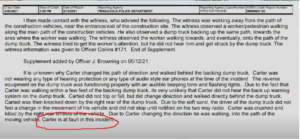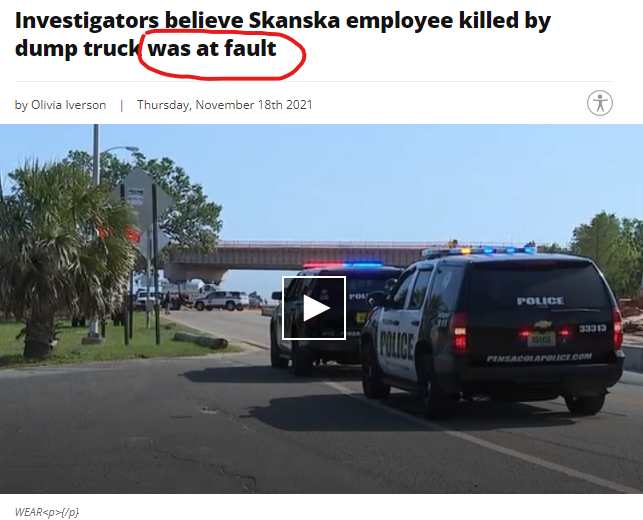Those of you who have been following the various iterations of this blog since I first started in 2003 know there are a few things that make me really, really mad: trench collapses, public employee deaths, and articles that blame worker deaths on a “freak accident” or claim it was the worker’s fault.
And here we go again. Check out the headline in the image above. Last April, Skanska Construction employee Mark Carter, 61, was killed when he was run over and crushed by a dump truck that backed up over him. The dump truck driver said that “I was backing up and I didn’t even — I didn’t even see him.” He said he saw Carter in his rear view mirror on one side, looked away, and didn’t see him when he looked back. He didn’t even know he had run him over until someone told him on the radio. The truck’s reverse beeper was working and other workers said they tried to warn Carter.
Those are the facts.
What was the cause? Why did he walk behind the truck? Was it his fault?

OSHA closed the case last Friday without a citation. The Pensacola Police Department (PPD) has just issued a report.
Unable to come up with any other answer, the PPD report concludes “Carter was at fault in this incident.” Inattentive guy for some unknown reason wandered behind a moving truck and got himself killed. What else could it be?
Carter’s step-daughter was understandably disappointed by the report’s conclusion. She says Carter “worked in construction for a large portion of his life — and knew worksite safety well.”
So, it’s a mystery.
Or is it?
Construction Site Deaths
I ran the health and safety program at AFSCME, the public employee union, for 16 years. Back in the day, the AFSCME website had a fairly comprehensive health and safety section section full of fact sheets and publications, which — until the powers-that-be found it too depressing — listed every AFSCME member that had been killed on the job. (These days you can look long and hard and futilely to find any health and safety information on AFSCME’s website.)
Year after year, the largest number of AFSCME members’ deaths were highway workers getting run over by construction vehicles.
Every year, too many AFSCME members died — from trench collapses, workplace violence, electrocutions, roadway incidents and other hazards. But year after year, the largest number of AFSCME members’ deaths were highway workers getting run over by construction vehicles. Why was this happening, and what could we do about it?
 I wanted to find out what was going on, so I visited AFSCME workplaces where members worked around large construction vehicles. It didn’t take long to figure out what was going on.
I wanted to find out what was going on, so I visited AFSCME workplaces where members worked around large construction vehicles. It didn’t take long to figure out what was going on.
One of the sites I visited was the Lorton (VA) Landfill. Huge transfer vehicles would collect garbage from the local DC garbage trucks at transfer stations and haul it out to Lorton where they would back into the dump area. Several vehicles would back into the same dump area at the same time, and some poor guy (an AFSCME member) would then run around to the back of the trucks, and manually open the doors. The trucks would dump the garbage and then the guy would close the huge doors up again.
It was hard work — hot and smelly, the air filled with dust and diesel exhaust fumes, and unceasing noise from the giant diesel engines and multiple backup beepers going off at the same time. It looked like a suicide mission to me and sure enough, just a few weeks later, one of those workers was hit by a truck — happily, with non-fatal injuries. How could he have been hit? All of the backup beepers were working? Was he just being careless?
Highway construction work is not much different. Heat, dust, exhaust and multiple heavy vehicles backing up and beeping at the same time. Workers, meanwhile, are trying to focus on their tasks, sometimes distracted by their tasks or suddenly remembering something and switching direction. Humans are fallible animals. All too often, they inadvertently cross paths with a 15-ton truck. And when it comes to 15-ton truck vs. 200 pound human, the truck usually wins.
What is to be done?
So, is this really a big problem? Or was I exaggerating things? Turns out, I wasn’t crazy. A National Institute for Occupational Safety and Health (NIOSH) document notes that the Bureau of Labor Statistics confirmed the problem:
According to a Bureau of Labor Statistics review of the 962 fatal workplace injuries at road construction sites from 2003 to 2010, 443 were due to a worker being struck by a vehicle or mobile equipment [BLS 2013]. Workers were fatally struck 143 times by a vehicle or mobile equipment that was backing up. In 84 of these cases, the worker was fatally struck by a dump truck that was backing up.
So what can be done about it? Is this just an issue of careless, inattentive workers? Nothing much to be done except urge distracted workers to really, really pay attention? And then attend their funerals and comfort their families if they don’t?
Is there nothing much to be done except urge distracted workers to really, really pay attention? And then attend their funerals and comfort their families if they don’t?
Maybe we should also punish the truck drivers (as if they aren’t suffering enough after running over their co-worker), but they can’t see what they can’t see. Most of those vehicles have pretty big blind spots.
Are there other solutions to this problem?
Yes. And they’re pretty obvious. Anyone who has purchased a new car over the last several years knows one of the answers. Since 2018, you can’t buy a new car without a rear view camera that will warn you if you’re about to run over the neighbor’s kid. In fact, most new cars today actually stop you vehicle before you collide with a sign post — or your dog or child.
But go out tomorrow morning and shop for a construction vehicle and it will likely not have any kind of rear view camera.
And cameras aren’t the only solution. OSHA has published a number of solutions and according to NIOSH, in addition to spotters behind every moving vehicle, additional live-saving technologies include:
collision avoidance or proximity warning systems (radar and sonar devices, or tag-based systems that use personal electronic tags to detect a marker field generated by a transmitter on the vehicle) or monitoring technologies (video cameras and additional mirrors) on construction vehicles and equipment to increase the likelihood that equipment operators will detect workers on foot around their equipment.
Skanska is a huge company, “one of the largest, most financially sound construction and development companies in the country,” with an impressive safety webpage. So why aren’t all of their vehicles equipped with backover prevention devices?
OSHA To the Rescue?
Imagine you spend 16 years at a union being frustrated about members getting killed from preventable backover deaths, especially when the technology is available to save those lives. Then imagine that a few years later, you’re running OSHA.
What are you going to do?
First a little education, like a fact sheet, video and finally, in Fall 2010, work on a standard covering “Backing Operations was added to OSHA’s Regulatory Agenda:
Statement of Need: A study by the Census of Fatal Occupational Injuries found that the most common primary sources of injury to be trucks (45%), road grading and surfacing machinery (15%), and cars (15%). That same study showed that of the 465 vehicle and equipment-related fatalities within work zones, 318 workers on foot were struck by a vehicle. Incidents involving backing vehicles were prominent among the worker-on-foot fatalities that occurred (51%). The primary injury sources of fatalities of workers on foot struck by a construction vehicle were trucks (61%) and construction machines (30%). OSHA believes that regulatory action is necessary to address risks associated with backup operations.
So, problem solved? Not hardly. OSHA’s regulatory process is glacially slow, especially when the agency’s narrow and underfunded regulatory pipeline is overfilled with important projects. OSHA conducted a Request of Information that was completed in 2012 and held three stakeholder meetings in 2013 (here, here and here). The small business review panel (SBREFA) was scheduled (and rescheduled) finally for April 2017, but before that could happen, the Trump administration disappeared the backover standard from OSHA’s regulatory agenda.
Mark Carter Was Not At Fault
So where does that leave us? First, Mark Carter was not at fault for his own death. His death was likely preventable. A rear view camera or numerous other technologies could have warned the dump truck driver that his co-worker was walking behind the truck.
Just because they can’t figure out why an incident occurred, doesn’t automatically mean that the worker was at fault.
Second, OSHA needs to put the backover standard back on its regulatory agenda and get together with the Department of Transportation to figure which agency can most quickly require all new construction vehicles to be equipped with technology to prevent backovers — and figure out how to require existing vehicles to be retrofitted. Unions can also ensure that contract language addresses the issue.
Third, Congress needs to pass a law requiring OSHA to cover public employees. Mark Carter worked for a private sector contractor, but plenty of public employees are killed as a result of backovers. In 24 states where public employees aren’t covered by OSHA, no one (except possibly the police department) will even investigate the work-related death of a public employee.
Finally, just because they can’t figure out why an incident occurred, doesn’t automatically mean that the worker was at fault. The root causes of such incidents need to be investigated and police departments need to leave workplace fatality investigations to the experts.

Every word of this post is true as can be– but let me offer one more ambitious suggestion.
***The White House “regulatory czar” (head of OIRA) ought to consider it her/his responsibility to examine EVERY health, safety, and environmental regulation and ask: “should the improvements being considered here be also given to workers?” ***
As soon as the NHTSA proposal to require backup cameras on all PASSENGER cars came out, OIRA should have seen that more backover fatalities occur in the workplace than in the community, and “prompted” OSHA to piggyback on this rule (and helped smooth the way for it). Ditto for many, many EPA rules that protect communities from parts per trillion while ignoring workers breathing parts per thousand. Ditto for Consumer Product Safety Commission rules that require devices on the shelf to be fitted with safety improvements not required for industrial use.
OIRA doesn’t have to be the place where regulations go to be nitpicked to death– it could be a place for true coordination and synergy.